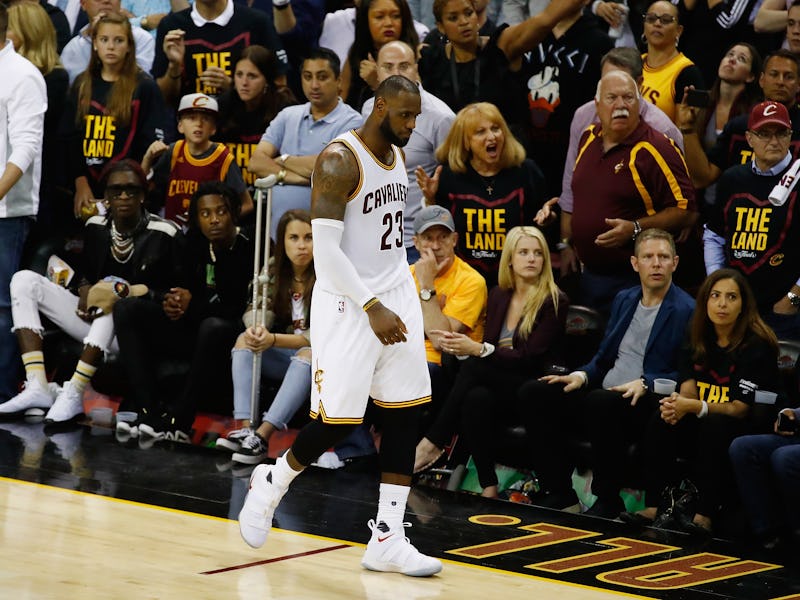Pissed-Off NBA Finals Crowds Say a Lot
When a player surveys the crowd, they instinctually know what they're thinking.

On Friday night, the Golden State Warriors will enter the Quicken Loans Arena in Cleveland like conquerors. The series stands at 3-0 in their favor. One more win, and they’ll take the title. A beleaguered, exhausted LeBron James, along with his supporting cast of Cavaliers, will face down the invaders from the west in front of a crowd of hometown diehards hoping for an even more dramatic recapitulation of last year’s comeback from a 3-1 deficit.
What’s it like to play in front of that kind of crowd? If game four goes anything like games one, two, and three, the mood in the arena will change fast. For a player on the court glancing up into the stands, the shift from hope to disappointment on fans’ faces will be just as palpable.
Stephen Curry of the Golden State Warriors shoots against Kevin Love of the Cleveland Cavaliers in the second half in Game 3 of the 2017 NBA Finals.
Figuring out the general mood at a glance from a whole panel of faces is a psychological process we’re only beginning to understand, according to research from a team of scientists at the University of Western Australia writing in the Journal of Experimental Psychology.
During an NBA game, for example, a player’s mind while flicking his eyes across a crowd is thinking one of two things. He might be just quickly recording one face after another, reading each expression separately, seeing the majority of angry faces, and deciding instantaneously it’s an angry crowd. On the other hand, his brain might have a kind of shortcut. We know that when looking at a group of simple objects, rather than process each of those objects separately, people will fuzz them all together in their heads — mixing the features of the objects all together into a kind of rough average. Then, if the average face looks pissed, they can simply assume that the crowd is collectively pissed.
At the end of the game, if a player scans the crowd, will he remember them smiling, or will that fuzzing effect cloud their expressions in his memory?
Andre Iguodala of the Golden State Warriors drives to the basket against LeBron James and Kevin Love of the Cleveland Cavaliers in the second half in Game 3 of the 2017 NBA Finals.
To figure out how people processed a group of faces, Australian researchers briefly showed their subjects panels of faces, four different faces at a time with different expressions. Then, after a beat, they showed their subjects one of those same faces. Sometimes the expression would be tweaked to be more or less angry, sometimes it would stay the same. Then they asked their subjects whether the face had the same expression as when they’d first seen it, or whether the expression had changed.
A figure from the paper lays out the experimental procedure the researchers used. The faces are drawn from a standardized database of faces and expressions.
If people were smearing the faces together in their heads, they’d be more likely to say a facial expression was the same when it was actually changed to be closer to the group average. If they were recording the faces individually, they’d be more likely to say it was the same when it was closer to its original expression. (A second experiment tweaked this setup a bit to rule out a bias toward the “most average” expression not related to a smearing effect.)
The results? When people glance at groups of faces, they don’t do a very good job remembering the expressions on those faces individually. Instead, they tend to smudge them all together. Even if a few people grinned in encouragement through the game, players will likely remember them as part of a scowling crowd. Great news for visitors who win at a game; bad news for the likes of LeBron and the hometown team, should they lose.